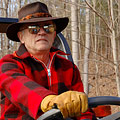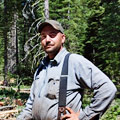Tools for Engaging Landowners Effectively
The Sustaining Family Forests Initiative (SFFI) has developed a research and education program, Tools for Engaging Landowners Effectively (TELE ), that enhances the ability of natural resource professionals to reach more family woodland owners with effective conservation and stewardship messages, services and programs. This is accomplished by using the principals of social marketing – namely understanding the attitudes, values and preferences of landowners in order to tailor communication, services, and programs. The program was piloted very successfully in the northeastern and Midwest US. We are currently expanding the program nationally. Successfully implemented, this will exponentially increase the number of owners participating in stewardship and conservation activities.
The centerpiece of the program is a 2-day intensive workshop where participants are taught the basics of social marketing and audience characterization, introduced to the landowner data for their state/region, and led through an actual project using those tools, techniques and materials. Over the course of the workshop, participants develop a landowner communication plan for their project with intensive hands-on coaching from the workshop leaders. This format has proven to be very successful at giving participants the information and tools they need to do more effective landowner outreach, which can be applied broadly to the work of their organizations.
TELE has identified 4 types of landowners based on their reasons for owning woodlands (as reported in the National Woodland Owners Survey)
 Woodland Retreat owners place high importance on lifestyle and amenity reasons for owning woods. They own their land primarily for its beauty and recreational value. These landowners are the largest segment, constituting 40% of all woodland owners. WR owners tend to be somewhat younger than the general landowner population, but, as with the other groups, about half are retired.
Woodland Retreat owners place high importance on lifestyle and amenity reasons for owning woods. They own their land primarily for its beauty and recreational value. These landowners are the largest segment, constituting 40% of all woodland owners. WR owners tend to be somewhat younger than the general landowner population, but, as with the other groups, about half are retired.
 Working the Land owners are best described as pragmatic individuals who have a strong and multifaceted interest in their land. They assign high importance to both lifestyle and financial reasons for owning woods. These landowners are the second largest segment, constituting 30% of all woodland owners.
Working the Land owners are best described as pragmatic individuals who have a strong and multifaceted interest in their land. They assign high importance to both lifestyle and financial reasons for owning woods. These landowners are the second largest segment, constituting 30% of all woodland owners.
 Supplemental Income landowners primarily own their land for investment and income purposes, rather than aesthetic, lifestyle, conservation, or recreational reasons. They also assign low ratings to personal uses of woodland, such as collecting firewood or non-timber products. They make up 8% of all woodland owners.
Supplemental Income landowners primarily own their land for investment and income purposes, rather than aesthetic, lifestyle, conservation, or recreational reasons. They also assign low ratings to personal uses of woodland, such as collecting firewood or non-timber products. They make up 8% of all woodland owners.
 Uninvolved owners give low importance ratings to all of the reasons for owning woods. They are just that - uninvolved, because they are neither motivated by timber income, nor particularly interested in the recreational or aesthetic benefits of owning their land. They make up 22% of all woodland owners.
Uninvolved owners give low importance ratings to all of the reasons for owning woods. They are just that - uninvolved, because they are neither motivated by timber income, nor particularly interested in the recreational or aesthetic benefits of owning their land. They make up 22% of all woodland owners.
What’s the Word on TELE?
“All the information shared was useful - from the data to the ‘audiences’ to the afternoon breakout session. It was one of the best workshops I have ever attended. I only wish we had more time to delve deeper” -VT workshop participant
“The facilitation was some of the best I have ever experienced” -VT workshop participant
“The TELE workshop provided us with the necessary tools to develop a clear communication plan(s) that will greatly improve our ability to communicate effectively, enable us to build long term relationships and the trust needed to succeed in achieving our conservation goals” - Idaho workshop participant
“This workshop went beyond my wildest expectations!” –Montana participant
“If you’re seeking advice on how to manage your woodland, you call a forester. If you’re seeking advice on how to get your message out effectively to a target audience, you call a media/business consultant. The TELE trainings provide the bridge of understanding necessary for a group of foresters and natural resource professionals to make our work relevant to the people we most need to reach” -Amanda Mahaffrey, Northeastern Director of the Forest Guild on behalf of the Kennebec Woodland Partnership